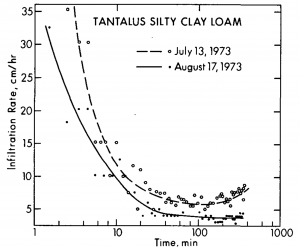6. Infiltration
In the prior chapter, we considered water inputs to the soil and the ways in which those water inputs can be altered due to interception. We also looked at the process of raindrop impact on the soil surface and its potentially harmful effects. Now, we are prepared to go-with-the-flow and consider the next step in the soil water balance—the process of infiltration. Infiltration is simply the process by which water enters the soil profile. Infiltration was the focus of perhaps one of the first and certainly one of the most influential soil physics teaching videos ever produced. That classic video produced at Washington State University in 1959 by Walter H. Gardner and his associate, J.C. Hsieh, inspired a modern remake created at the University of Gembloux in Belgium and available here (link). Please take the time now to watch that video, which will help you better visualize and understand key features of the infiltration process.
The infiltration rate is the volume of water flowing into the soil per unit of surface area per unit time. As seen in the video above, infiltration rates typically decrease over time during the course of an infiltration event, approaching a relatively constant and low rate if the infiltration event is prolonged. You can see in Fig. 6‑1 how the infiltration rates initially declined sharply then approached a fairly constant level during ponded infiltration into a silty clay loam soil in Hawaii [1]. The fundamental cause of this decrease in infiltration rates over time was one of the main scientific mysteries in the early days of the soil physics and hydrology. This mystery was studied in detail by an American engineer named Robert Horton, one of the most prominent early hydrologists.


